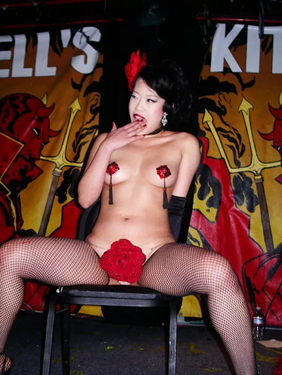15.6: Street-Based Sex Work
- Page ID
- 168067
Street based sex workers experience some of the highest levels of stigma and violence of all sex work. According to Cimino (2014), in the United States, street-based sex workers are seen as “deviant” and “dangerous” by society, while escorts or so-called “high-class” sex workers are viewed as “seeking economic independence and personal empowerment”. Armstrong (2019) documents the connection between stigma and violence, and argues for the decriminalization of sex work, in order to protect sex workers. Street-based sex workers often do not have the option to assess clients for safety before getting in a car or going to a private space with them. They have less control over who their clients are, and they are also at higher risk of harassment and violence by law enforcement. They are subject to loitering laws that criminalize them for being on the street. This allows the police to profile, harass, and arrest them repeatedly (Chabria, 2022).

McCracken (2013) draws connections between stigma, systemic violence and victim status. She speaks to the danger of attributing a victim status to street-based sex workers. “These individuals have power, expertise and knowledge, and others can learn from them on both individual and systemic levels. Understanding every individual is capable of agentic choice, shifts the kaleidoscope and subsequently changes the view” (McCracken, 2013, p. 239).
Stripping falls under the umbrella of sexuality work that engages the body. Within stripping, there are various subcategories. The classic Burlesque shows (a variety show, typically including striptease), pole dancing, lap dancing and peep-shows are all forms of stripping. Here, “stripping” will be defined as “any act in which money is exchanged for the pleasure of watching another human dance or/and remove items of clothing”. This section will include stories from a former sex worker who worked in San Francisco, where various forms of stripping exist as part of the legal sex work trade. Over the years, the number of these establishments have ebbed and flowed, coinciding with various laws and restrictions on sex work in this area of the industry. Support for the workers themselves is as fluid as the laws and attitudes towards sexuality of the culture. As shown throughout this text, the laws about sex work is varied and constructed by norms and values. There are many types of stripping, which can appeal to different people based on their individual preferences. This section will include only strip clubs and venues that housed women strippers and traditionally catered to men, because that is the only sex work experience the author has had.

The Cinema on Market Street housed a classic stage, where women would perform dances while removing their clothes. Men in the audience would watch as other women dressed in lingerie would ask to sit on their laps for personal dances. The rules were: no touching below the waist, and a woman would dance on the man’s lap for money. Rules were not strictly followed, and in reality, the women would at times rub their thighs/buttocks or use their hands to help the men ejaculate, and in some cases, there was penetration.
Across the street was the Regal Show World, which housed pornography booths where customers could drop quarters into a slot to watch pornographic movies. There were also rentals of movies and booths for longer viewings of the movies. These booths included a bench for sitting, tissue for cleaning up and a locked door. The Show World also had booths with live girls that worked behind glass. As you walked into the Regal Show World, it was like walking into a large movie theater with a sloped ramp leading you down to the action. On the right hand side, there was a desk where typically two men worked, mostly making change, renting and selling movies and “cashing out” the workers. On the wall next to the counter was a window to a hallway, where women would check in and out of work. As customers walked past the counter, there were booths of women on one side and movies on the other, and at the end of the hall was a dome for pole dancing. The dome was closed with small booths with signal doors around the stage for viewing. Customers could talk to the women that were in the booths preceding the “dome” and negotiate what might happen if they were to enter a signal booth, or they could duck right in. The women would close the booth door where they were sitting and wait for the customer behind the glass to insert at least $5 to clear the glass window. The worker was sitting on a very small “bed” and had a phone, with which they could communicate with the customer. These conversations would range from complex fantasy work and role playing of sexual intercourse, to simply watching the women take off their clothes. The women generally started in a bra and panties, so the layers of clothes needed to be removed was minimal. Since the glass only stayed clear as long as money was being pumped in through an electronic slot, the worker’s skill was to continue to prolong a session so that the customer would “feed the meter.” The women that worked there would informally discuss the pay scale in the upstairs dressing room prior to our shifts. There was an understanding that for $5 (of which the worker got half), the viewer would get the bra off, and $10 would call for the removal of the panties. This of course was part of the game. The skill involved trying to get the customer to pick up the phone and ask, “what do you like?” While slowly negotiating this, we would remove our bra so that just as it came off the glass would fade. At this point in the transaction the customer would either leave or insert another $5, or a larger tender depending on the situation. Upstairs in the dressing room, the conversations about money, shows and what the women would or would not do continued. For example, “Betsey would masturbate with a coke bottle for $5” and, “Maria, she always got guys in her booth for $20 off the bat.” Thinking back on these situations, the conversations and interactions in the dressing room were rich and complex. The women were diverse in age, race and life choices.
Workers were paid half of all the money they got in their booth during their 4 hour shift, but it was set up so that the worker actually was paying a fee to the theater to rent the booth. This fee was 50% of the money made during the rental time. In most of the stripping world, both women and men were paid as independent contractors. There was no guarantee of work or healthcare, which led to a unionization movement in San Francisco during the late 1990’s. Unlike prostitution, this field of sex work is legal, and therefore, workers could mobilize. In a similar way to prostitution, the world of strippers provided a needed service for people that desired human touch or fantasy. In many cases, stripping did border towards prostitution, with lines blurred, or in many cases, even crossed. For example, in the lap dancing world of a dark theater, sometimes penetration took place.
The author for this section worked in both peep-shows and lap dance theaters, but found greater comfort in the peepshow area. The glass provided a safety net, the phone and the “booths” provided an intimate environment to exchange nudity, sexual interactions and fantasies. In the era this took place, the workers were all women, and the majority of the customers were men. The story below describes a real experience the author had with a client who was seeking an outlet for their sexual needs.


